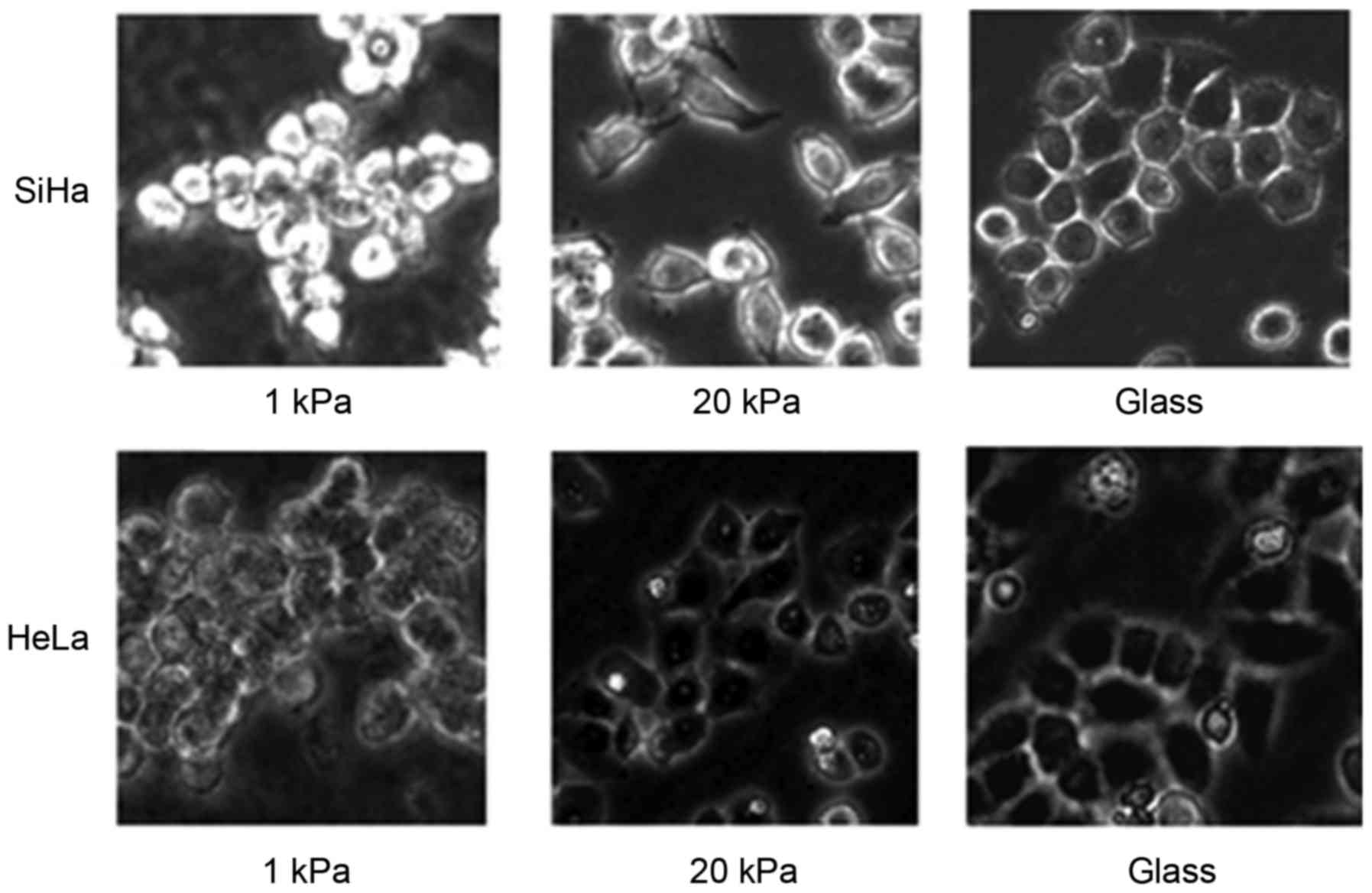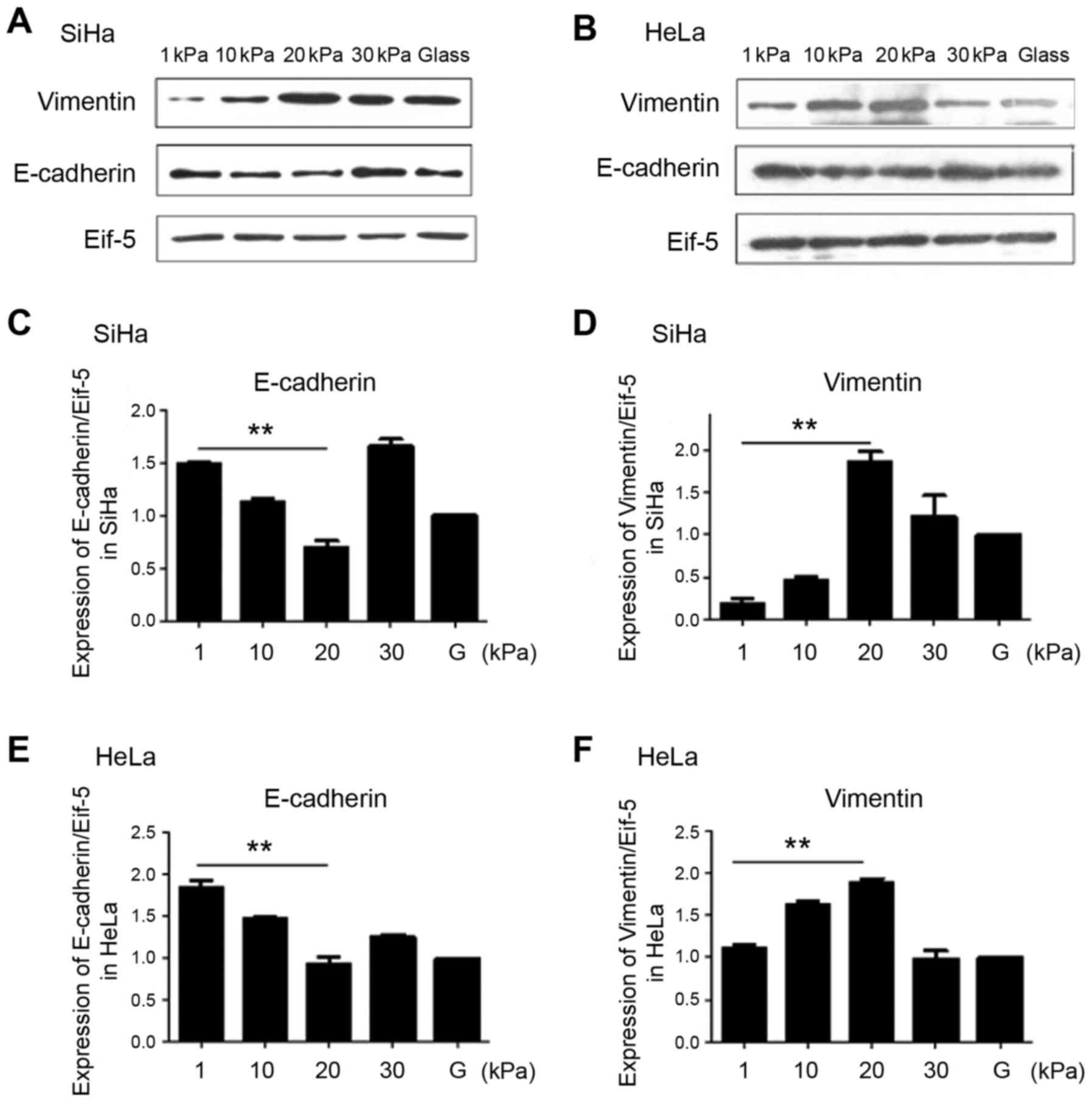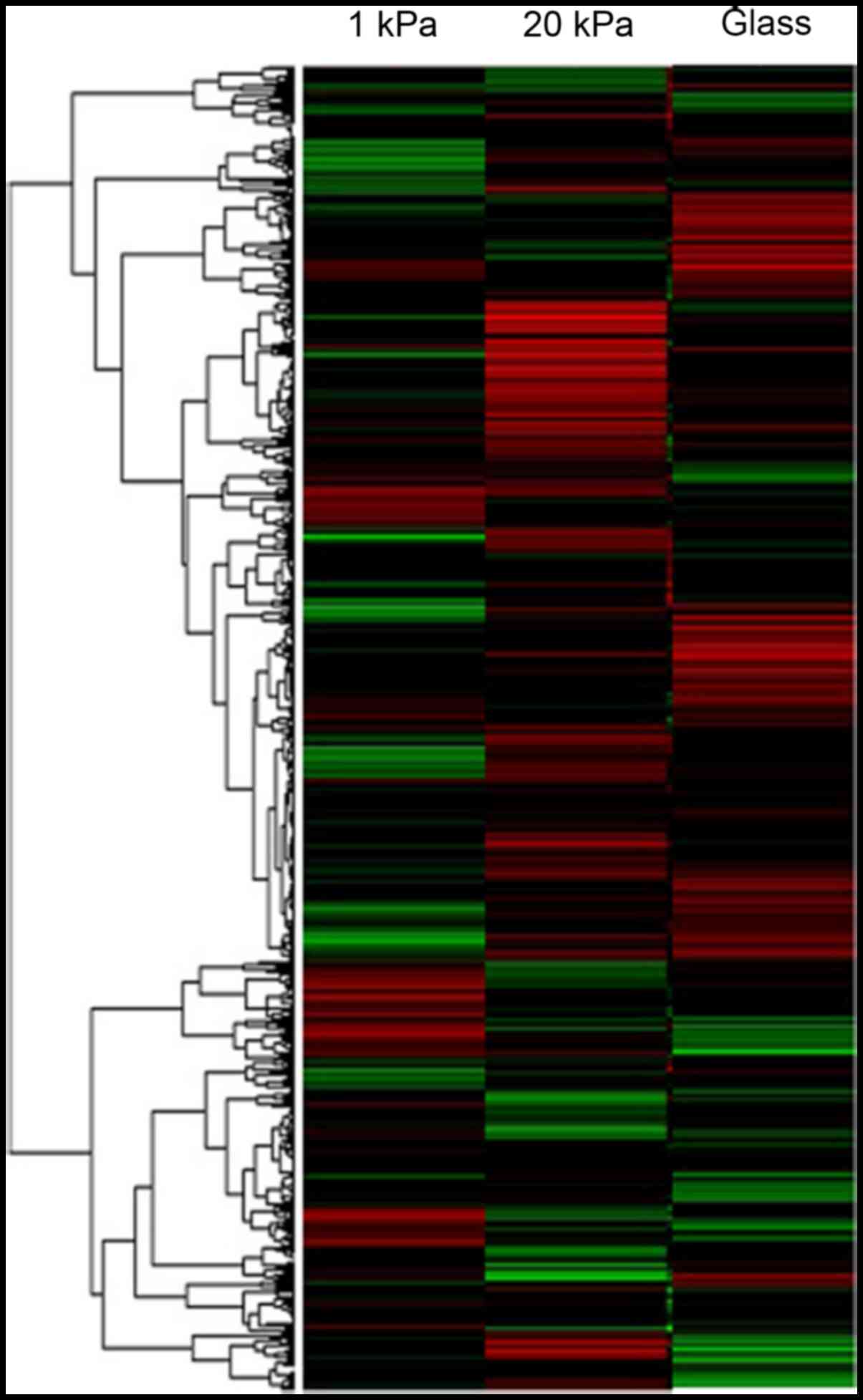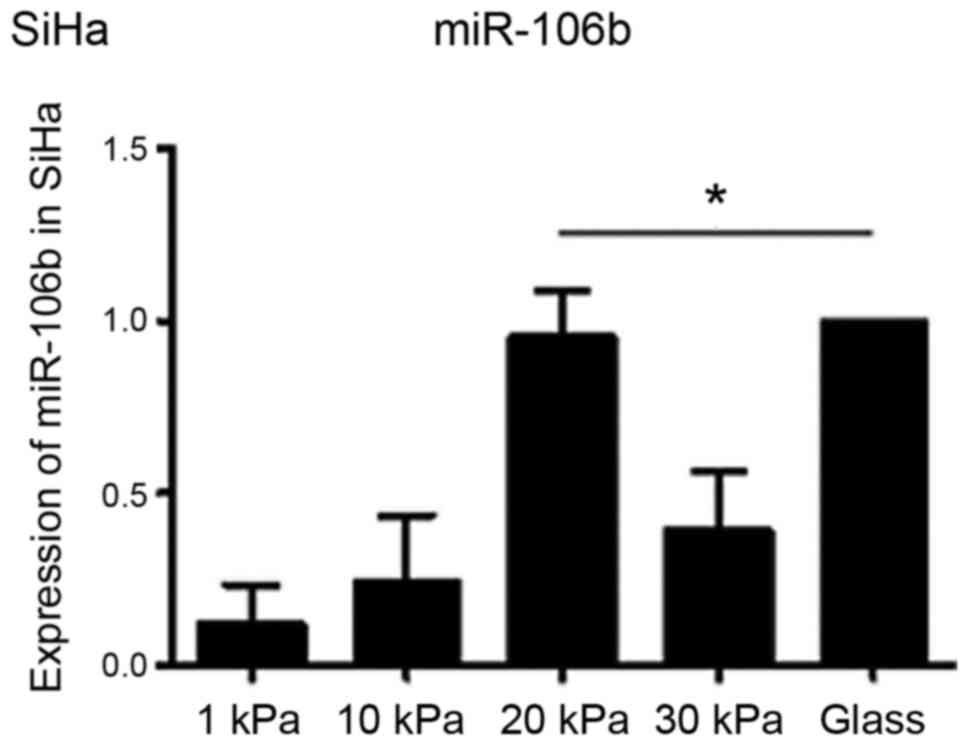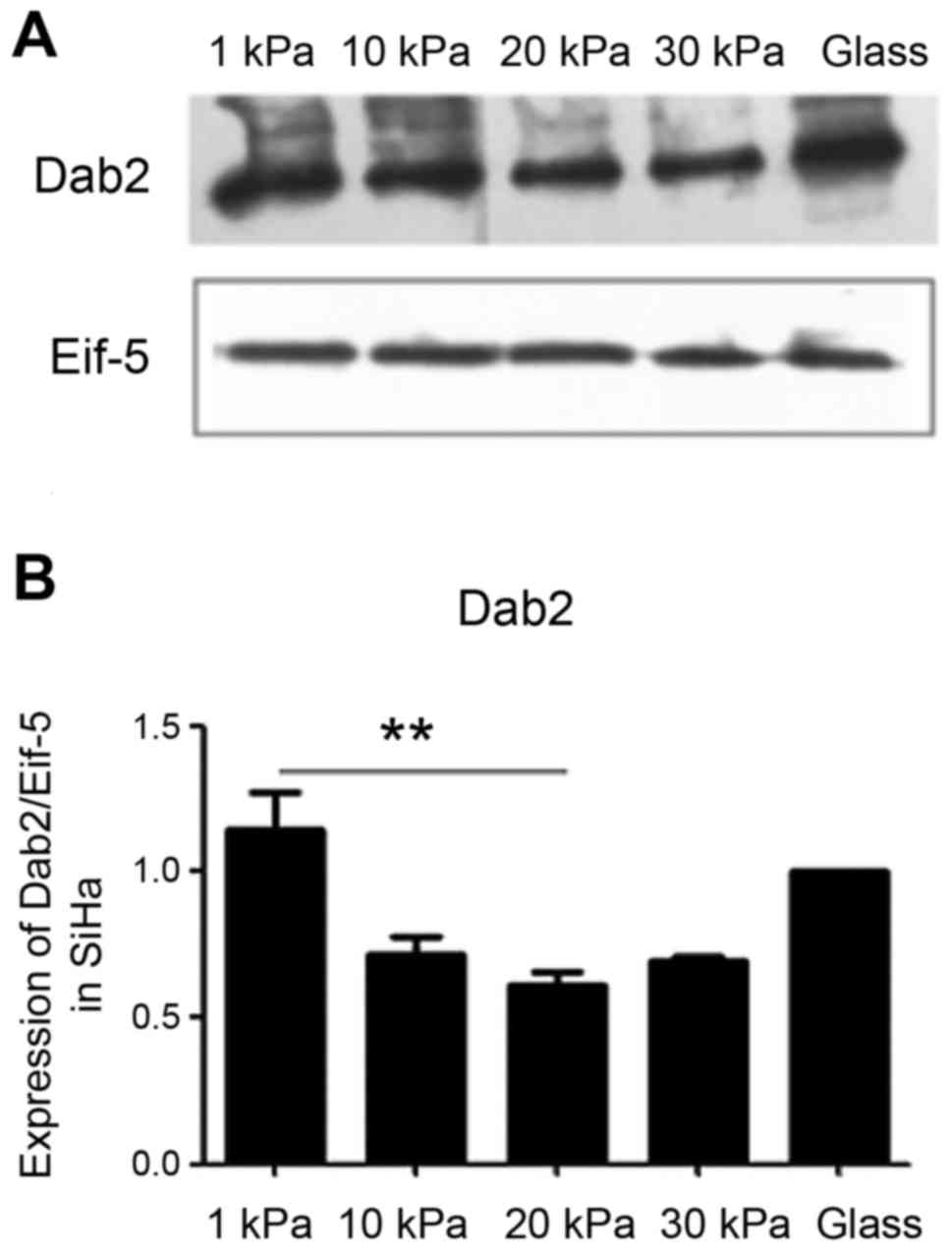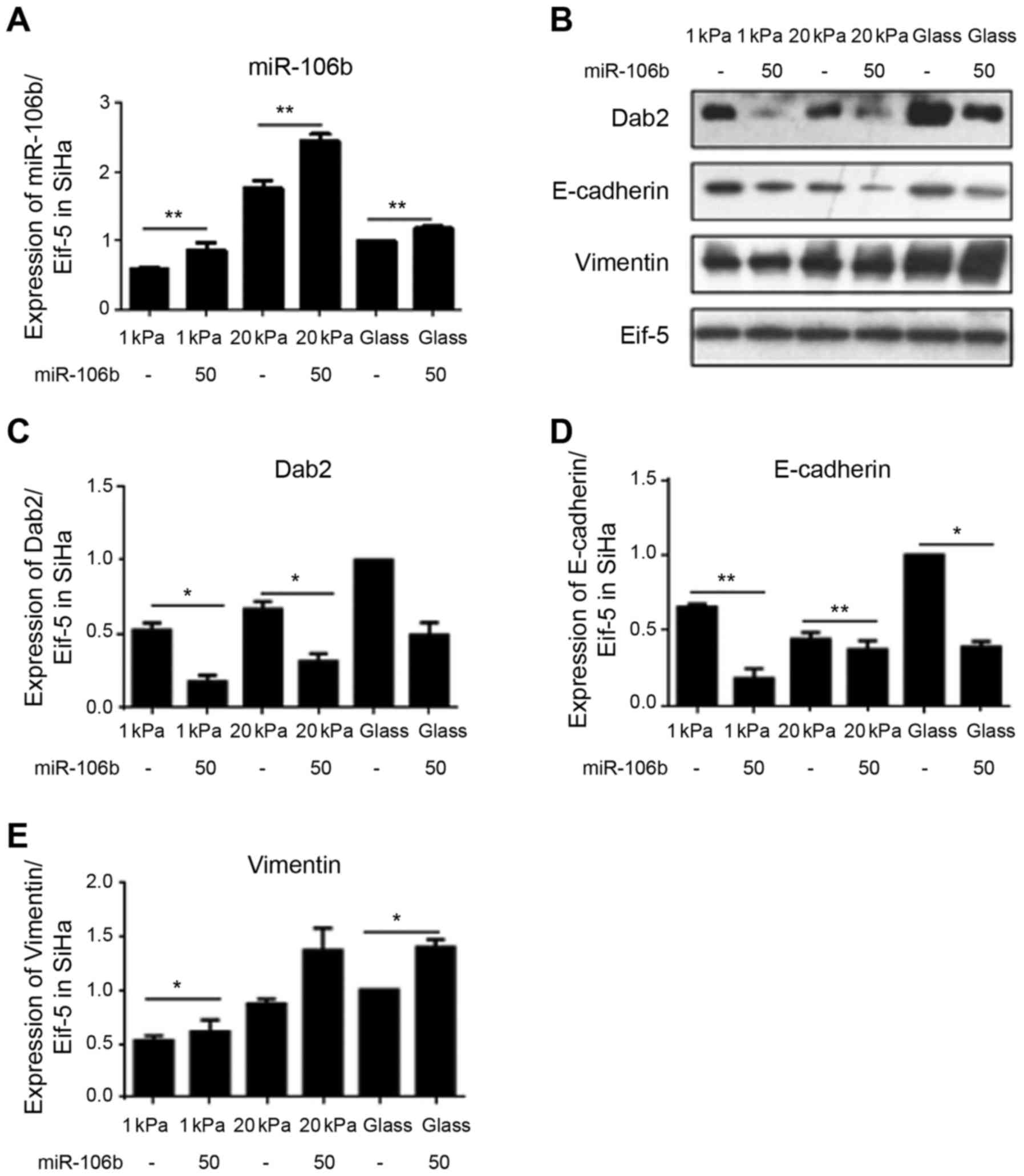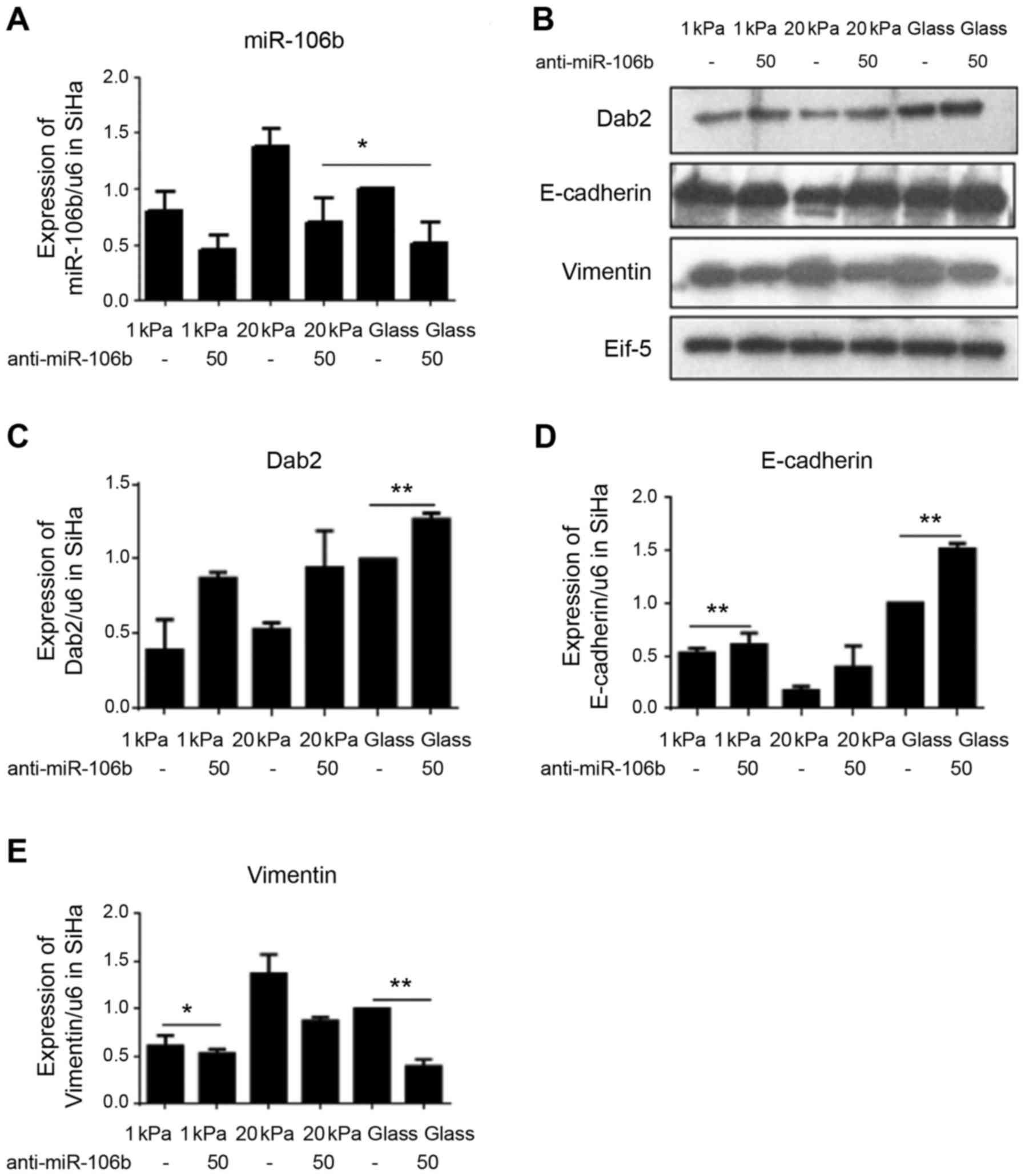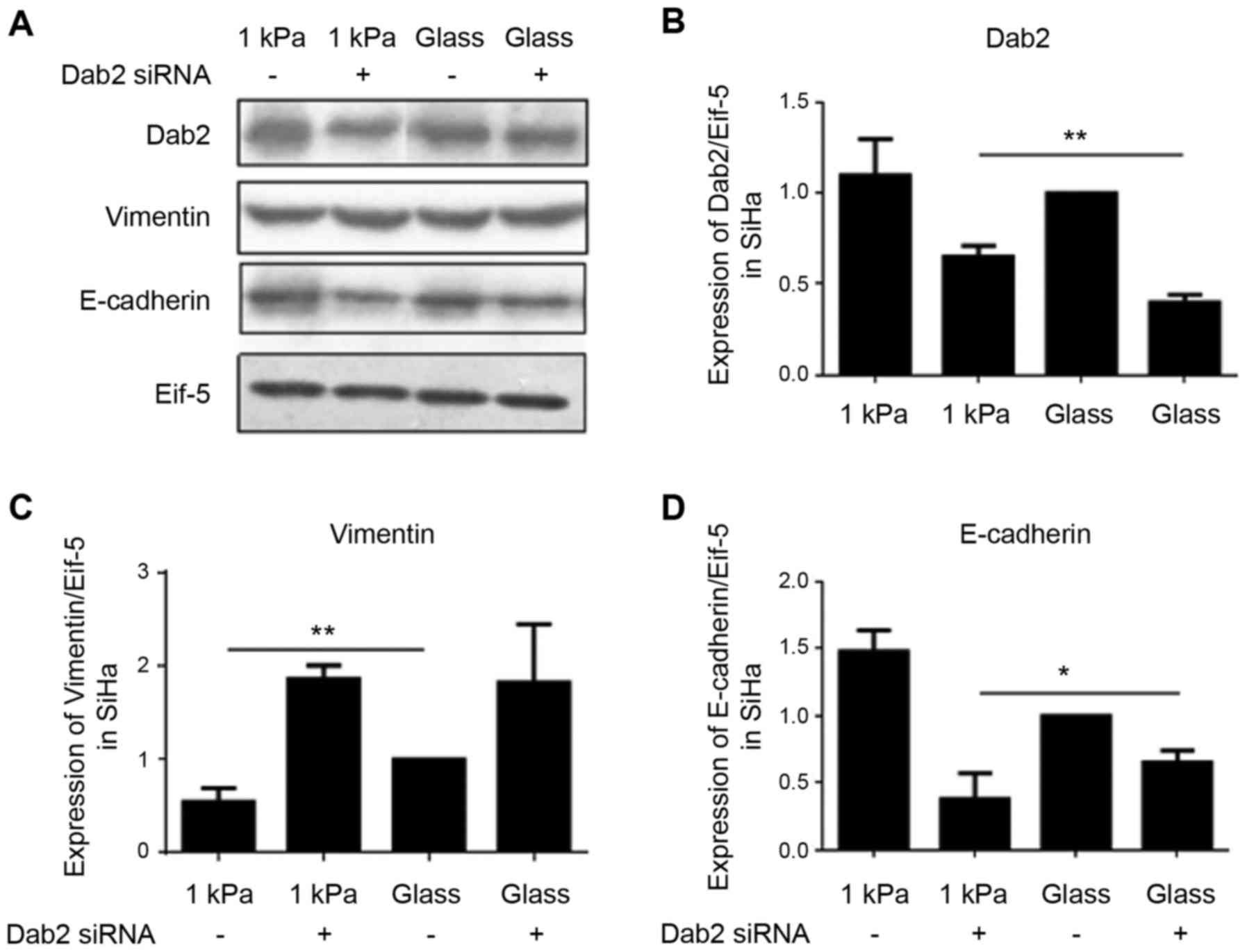Substrate stiffness affects epithelial-mesenchymal transition of cervical cancer cells through miR-106b and its target protein DAB2
- Authors:
- Published online on: April 27, 2017 https://doi.org/10.3892/ijo.2017.3978
- Pages: 2033-2042
Abstract
Introduction
Cervical cancer is the world's fourth most common female malignancy and ranks the second in the developing countries and the third in the developed countries, seriously affecting the health of women worldwide. Each year there are around 500,000 new cervical cancer cases and 266,000 deaths, of which more than 80% are in developing countries. It is estimated that there are approximately 62,000 new cases and 30,000 dead cases each year in China, and its annual incidence increases by 2–3%. In addition, the onset age of cervical cancer patients in recent years has decreased, and the incidence of cervical cancer increases sharply in the age group of 25 to 34 years, causing great concern world-wide (1–3).
According to recent epidemiological investigation, clinical stage is one of the risk factors affecting prognosis of patients with cervical cancer: the later the stage, the worse the prognosis of the patients (4). These findings indicate that invasion and metastasis are the main causes for poor prognosis and high mortality of patients with cervical cancer and these difficult problems need to be solved. Studies have found that epithelial-mesenchymal transition (EMT) is the primary step causing cervical cancer invasion and metastasis and its relationship to tumor progression is gradually drawing more attention (5–7). EMT is a phenomenon where epithelial cells lose their polarity and gradually shift to mesenchymal cell morphology under certain pathological stimulations. The process is accompanied with cell morphological changes and increased ability to alter cell motility, thus further affecting cell migration (8,9).
Recent studies have found that changes in the mechanical properties of the extracellular matrix, i.e. the substrate stiffness, could regulate EMT and other biological functions of tumor cells. In other words, mechanical properties of extracellular matrix play a major role in tumor progression. Studies have found that changes in substrate stiffness can affect EMT of breast cancer cell lines, lung cancer cell lines and hepatoma cell lines (10,11). In addition, human tissue stiffness changes significantly with disease progressing. For example, the stiffness of normal breast tissues is around 4 kPa, while that of cancerous breast tissues is approximately 12 kPa (7,12–16). Moreover, studies have shown that tumor-associated fibroblasts and interstitial fibrosis components which is produced by fibroblasts, such as α-SMA, laminin and fibronectin increase significantly with cervical cancer progression, suggesting that the stiffness of cervical cancer tissues is higher than that of normal cervical tissues (16). However, whether the mechanical properties of extracellular matrix can influence EMT of cervical cancer cells has not been reported.
MicroRNA is a small RNA with post-transcriptional regulation functions. MicroRNA regulate expression levels of important oncogenes and tumor suppressor genes, and further regulate cancer cell invasion and metastasis. Previous studies have found that the mechanical signals of extra cellular matrix can alter microRNA expression in cells (17–19). For example, miR-29 expression was significantly increased by bladder obstruction-induced increase in bladder tissue stiffness (19); microRNA expression changes in alveolar epithelium and mesothelial cells under different mechanical shear stress. In other words, different substrate stiffness can affect some microRNA expression in cells, therefore regulating cell functions by targeting degradation of important proteins (20). Mouw et al found that mechanical stiffness of extracellular matrix could regulate PTEN expression and its downstream PI3K/AKT signaling pathway and promote breast cancer occurrence through microRNA, indicating that microRNA is an important key node in transducing mechanical signals to cells (21).
Our previous study established a related miRNA-mRNA regulatory network diagram through mRNA and microRNA chips analysis of normal cervical tissues and cervical cancer tissues and found that miR-106b is a key node in the network and closely related to cervical cancer cell migration. In addition, our previous study also found that miR-106b was significantly upregulated in cervical cancer tissues and could promote EMT and migration of cancer cells by degrading its target protein DAB2 (22).
In this study, we explored whether substrate stiffness can affect EMT of cervical cancer cells, and the role of miR-106b and its target protein DAB2 in this process.
Materials and methods
Artificial substrate preparation
Artificial substrates with different stiffness were prepared using acrylamide and bisacrylamide at different ratios and laid on 24×24 mm slides. After irradiated with UV light for 2 h, they were used to grow cervical cancer cell lines.
Cell culture
The cervical cancer cell lines SiHa and HeLa were cultured in DMEM medium supplemented with 10% FBS, 100 U/ml penicillin and 100 mg/ml streptomycin at 37°C in a humidified incubator supplemented with 5% CO2. When cells reached 70–80% confluency, they were transferred on artificial substrates.
Western blotting
Proteins were extracted from cervical cancer cell lines HeLa and SiHa and semi-quantitated with Coomassie brilliant blue. A total of 10 µg protein of each sample was separated on 10% SDS-PAGE and transferred onto PVDF membrane. The membrane was then blocked with 5% skim milk at 37°C for 1 h. Target proteins on the membrane were recognized by incubating with appropriate primary antibodies (rabbit anti-human E-cadherin, mouse anti-human vimentin, rabbit anti-human Twist1 and rabbit anti-human Eif-5 antibodies, respectively) at room temperature for 4 h. After rinsed with TBST three times for 5 min each time, the protein-antibody complexes were recognized by alkaline phosphatase-labeled anti-IgG (1:1000) antibody by incubating at room temperature for 1 h. After rinsed with TBST three times for 10 min each, the complexes were visualized by incubation with NBT/BCIP. The gray scale images were scanned and protein expression was analyzed using Eif-5 as the internal control and expressed as relative RGS. Each experiment was repeated 3 times.
Real-time PCR
Total RNA were extracted using TRIzol from SiHa cells cultured on substrate with different stiffness. mRNA were reverse transcribed into cDNA and subjected to fluorescence quantitative PCR at the condition of denature at 95°C for 2 min followed by 40 cycles of 95°C for 30 sec, 55°C for 30 sec and 72°C for 30 sec using primers shown in Table I on Bio-Rad PCR real-time PCR instrument. Expression levels of DAB2 and vimentin were normalized to internal control Eif-5. Each experiment was repeated three times.
MicroRNA chip analysis
Total RNA was extracted using TRIzol from SiHa cells cultured on substrates with stiffness of 1 kPa and 20 kPa as well as on a glass plate were reverse transcribed with the Qiagen RNeasy Mini kit and subjected to microRNA chip analysis using Genisphere FlashTag Labeling kit from Beijing CapitalBio Corp.
Statistical analysis
The results are expressed as mean ± SEM. Differences among multiple groups were compared using one way ANOVA. Samples with different variance between two groups were compared using non-parametric tests. P<0.05 was considered to indicate a statistically significant difference. Graphs were plotted using GraphPad Prism 5.0 software (GraphPad Software Inc., La Jolla, CA, USA).
Results
Selection of substrate stiffness range
It was reported that the average stiffness of human solid tumors is approximately 20 kPa. The stiffness of most solid tumor tissues before canci-genesis is higher than that of normal tissues (7). Therefore, in this study, the artificial substrates were prepared to have stiffness of 1, 10, 20 and 30 kPa, respectively, and glass plate was used as control.
Effects of substrate stiffness on the morphology of cervical cancer cell lines SiHa and HeLa
SiHa and HeLa cells were cultured on artificial substrate with stiffness of 1 kPa to represent their normal condition and on artificial substrate with stiffness of 20 kPa to represent cervical tumor tissues. Morphological observation showed that cells cultured on artificial substrate with stiffness of 1 kPa were spherical and hardly had pseudopodia, while cells cultured on artificial substrate with stiffness of 20 kPa were rich in pseudopodia (Fig. 1), indicating that SiHa and HeLa cells have stronger migration ability when cultured on artificial substrate with stiffness of 20 kPa than cultured on artificial substrate with stiffness of 1 kPa.
Effects of substrate stiffness on EMT of cervical cancer cell lines SiHa and HeLa
First, we detected the expression level of EMT markers in SiHa and HeLa cultured at artificial substrate with different stiffness using real-time PCR. The results showed that mRNA levels of vimentin were significantly lower in SiHa and HeLa cells cultured on artificial substrate with stiffness of 20 kPa than cultured on substrate with stiffness of 1 kPa, and the expression level of E-cadherin higher in stiffness of 20 kPa than 1 kPa (Fig. 2).
Expression levels of EMT markers E-cadherin and vimentin in SiHa and HeLa cultured at artificial substrate with different stiffness was also detected using western blotting. The results showed that protein levels of E-cadherin is significantly lower in SiHa and HeLa cells cultured on artificial substrate with stiffness of 20 kPa than cultured on substrate with stiffness of 1 kPa, and expression levels vimentin is significantly higher in stiffness of 20 kPa than 1 kPa (Fig. 3).
The above results indicate that cervical cancer cell line SiHa and HeLa had stronger EMT ability when cultured on artificial substrate with stiffness of 20 kPa than cultured on substrate with stiffness of 1 kPa.
Effects of substrate stiffness on Twist1 expression of cervical cancer cell line SiHa
We detected the expression level of Twist1 in SiHa which were cultured at artificial substrate with different stiffness using western blotting. The results assessed by western blotting showed that Twist1 expression was the highest in 30 kPa on glass, lowest in 10 kPa situation. However, when tested by Real-time PCR the Twist1 expression was the lowest in 20 kPa situation excluding on glass. Expression of Twist1 of the cervical cancer cell line SiHa is not consistent with EMT tendency (Fig. 4).
Effects of substrate stiffness on microRNA expression in cervical cancer cell lines SiHa and HeLa
To explore whether microRNA is involved in regulating EMT of cervical cancer cell lines cultured on substrates with different stiffness, we tested differential expression of microRNA using microarray test. SiHa cells cultured on substrates with stiffness of 1 kPa and 20 kPa as well as on glass plates for 36 h. Their total RNA was extracted and used for microRNA chip analysis to detect differential expression of microRNA. Cluster analysis clearly showed that 173 microRNA were deferentially expressed in cervical cancer cell line SiHa cultured on substrates with different stiffness (Fig. 5). Among them, 70 microRNA including miR-106b were upregulated and 103 microRNA were downregulated in SiHa cells cultured on substrates with stiffness of 20 kPa (p<0.05, FRD<0.05). Tables II and III list the microRNA that were mostly upregulated and down-regulated in SiHa cells cultured on substrate with stiffness of 20 kPa compared with cells cultured on substrate with stiffness of 1 kPa, respectively. Obviously, substrate stiffness can affect microRNA expression in cervical cancer SiHa cells, wherein miR-106b may play an important regulatory role.
Table IITop differentially upregulated microRNAs in cervical cancer cells cultured on substrates with stiffness of 1 and 20 kPa, respectively. |
Table IIITop differentially downregulated microRNAs in cervical cancer cells cultured on substrates with stiffness of 1 and 20 kPa, respectively. |
Effects of substrate stiffness on miR-106b expression in cervical cancer cell line SiHa
To understand whether substrate stiffness affects EMT of cervical cancer cell lines through miR-106b, miR-106b expression in cervical cancer cells was further measured and verified using real-time PCR. The results (Fig. 6) confirmed that miR-106b expression was indeed upregulated in cervical cancer cell line SiHa cultured on substrate with stiffness of 20 kPa. Considering that SiHa cultured on substrate with stiffness of 20 kPa had stronger EMT ability than SiHa cultured on substrate with stiffness of 1 kPa, the result suggests that substrate stiffness might regulate EMT of cervical carcinoma cell line SiHa by regulating miR-106 expression.
Effects of substrate stiffness on expression of tumor suppressor protein DAB2 in cervical cancer cell line SiHa
To further investigate whether substrate stiffness affects EMT of cervical carcinoma cell line SiHa through miR-106b and its target protein DAB2, the level of DAB2 in cervical cancer cell line SiHa was examined by western blotting. The results (Fig. 7) showed that the expression level of DAB2 was significantly different in SiHa cells cultured on substrate with different stiffness and lower in cells cultured on substrate with stiffness of 20 kPa, suggesting that substrate stiffness may regulate EMT through miR-106b targeted DAB2 degradation.
miR-106b is involved in substrate stiffness regulated EMT of cervical cancer cell line SiHa
To investigate the specific mechanism, substrate stiffness of 1 and 20 kPa was selected to represent normal cervical tissue stiffness and cervical cancer tissue stiffness, respectively, and the changes in expression levels of miR-106b target protein DAB2 and EMT-related markers vimentin and E-cadherin after miR-106b over expression and silencing were detected using western blotting. Fig. 8 shows that miR-106b overexpression significantly decreased the expression of DAB2 and vimentin, but increased the expression of E-cadherin in cervical cancer cell line SiHa cultured on substrate with stiffness of 20 kPa. Fig. 9 shows that miR-106b silencing significantly increased the expression level of DAB2 and vimentin and decreased the expression level of E-cadherin in cervical cancer cell line SiHa cultured on substrate with stiffness of 20 kPa. Together, these data suggest that substrate stiffness regulates EMT of cervical carcinoma cell line SiHa through miR-106b and its target protein DAB2.
DAB2 is involved in regulating EMT of cervical cancer cell SiHa
To further investigate whether DAB2 is involved in regulating EMT of cervical cancer cells in different substrate stiffness, we explored the effect of DAB2 knockdown on the expression of E-cadherin and vimentin in cervical cancer cell SiHa cultured on substrate with the stiffness of 1 kPa using western blotting. The results showed that DAB2 knockdown significantly decreased EMT-associated E-cadherin level and increased vimentin level, i.e. enhanced EMT, indirectly suggesting that DAB2 is involved in substrate stiffness regulation of EMT of cervical cancer cell line SiHa (Fig. 10).
Discussion
Substrate stiffness affects EMT of cervical cancer cells
In this study, we explored the effects of substrate stiffness on EMT of cervical cancer cells. Changes in substrate stiffness are important signs of many epithelial tumors and can regulate EMT of many important cells such as liver epithelial cells and different types of cells. EMT of hepatocytes is stronger on substrate with stiffness of 60 kPa (hard substrate) than on substrate with stiffness of 11 kPa (soft substrate) (23); EMT of mouse mammary epithelial cells is stronger on substrate with stiffness of 11 kPa (hard substrate) than on substrate with stiffness of 4 kPa (soft substrates) (24); EMT of alveolar epithelial cells is stronger on substrate with stiffness of 17 kPa than on substrate with stiffness of 4 kPa. All these results indicated that EMT of different types of tumor cells requires different extracellular conditions. In our study, we found that cervical cancer cell lines are more prone to EMT on substrate with stiffness of 20 kPa than 1 kPa, and less prone to EMT on substrate with stiffness of 30 kPa than 20 kPa. Substrate stiffness of 20 kPa is currently considered as average stiffness of human solid tumor tissues and very close to the stiffness of cervical cancer tissue, suggesting that cervical cancer cells are prone to EMT at certain substrate stiffness while are not prone to EMT at other conditions.
Substrate stiffness affects EMT of cervical cancer cells through miR-106b and its target DAB2
In recent years, many transcription factors and signal pathways have been shown closely related with EMT of cancer cells. Research on transcription factors have not made substantial progress (5). In our investigation we also tested the transcription factor Twist1 which has a close relation with EMT of cervical cancer. We found the expression of Twist1 1 kPa condition the lowest and the expression of Twist1 the highest in 30 kPa condition. Thus, the expression of Twist1 does not match the EMT tendency (Fig. 10). The impact of microRNA on tumorigenesis has gradually become a hot topic of research. It is well acknowledged that microRNA is closely related to pathological process of several kinds of cancers such as cervical cancer (17,18).
Importantly some studies have found that specific microRNA can regulate EMT of tumor cells (25–32). In the present study, we found that miR-106b and its target protein DAB2 play significantly important regulatory roles in EMT process of cervical cancer cell lines SiHa and HeLa. In our study, we found that miR-106b and DAB2 play important roles in regulating EMT of cervical cancer SiHa and HeLa cells which were caused by changes in substrate stiffness. In other words, with substrate stiffness changing, miR-106b expression in cervical cancer cell lines changes significantly. Suppression or overexpression of miR-106b correspondingly alters the expression of EMT markers, indicating that substrate stiffness may affect EMT of cervical cancer cells through microRNA. This view is also supported by other studies. Mouw et al found that changes in substrate stiffness increased miR-18a expression and promoted breast cancer development by regulating expression of its target protein PTEN (21). It is clear that miR-106b is an important key node in mechanical signaling transduction in cervical cancer HeLa and SiHa cells and microRNA can be the key component in mechanical signal transduction process.
It is currently accepted that integrin is the cell membrane receptor of mechanic signals. It sensors extracellular mechanical signals and transfers the signals into intracellular signals to further regulate expression of important genes and cellular functions such as growth, proliferation, migration and EMT. It has been reported that some microRNA may further affect integrin receptor expression or activity through their target proteins and associated signaling pathways to influence cell EMT, migration, invasion and other cell functions (30,31). It is possible that changes in miR-106b expression due to substrate stiffness may also affect expression or activity of certain specific cell membrane integrin receptors and further the transduction of extracellular mechanical signals into intracellular signals. This hypothesis need to be further explored.
Moreover, microRNA usually regulate the expression of its target proteins by post-translational degradation. Our results found that miR-106b target protein DAB2 could regulate EMT of cervical cancer cell lines cultured on substrates with different stiffness. Many studies have found that loss of expression of tumor suppressor protein DAB2 can significantly promote EMT of many tumor cells, including cervical cancer cells. To our knowledge, whether different substrate stiffness can regulate DAB2 expression has not been reported previously. Our results showed that substrate stiffness could affect DAB2 expression. DAB2 expression is the lowest in cervical cancer cell lines cultured on substrate with stiffness of 20 kPa and the highest in cervical cancer cell lines cultured on substrate with stiffness of 1 kPa.
The characteristics that tumor tissues have different stiffness in ultrasound and elastography examinations have been used in clinical medicine for preliminary tumor diagnosis (32–34). Our results showed that substrate stiffness can regulate EMT of cancer cells. We have previously shown that miR-106b expression is higher in cervical tumor tissues than in normal cervical tissues, and high miR-106b expression promotes cervical carcinogenesis. In this study, we found that at cytological level, miR-106b plays an important regulatory role in EMT of cervical cancer cell lines cultured on substrates with different stiffness, suggesting that miR-106b and substrate stiffness play important roles in cervical cancer progression. Our results also suggest that changes in substrate stiffness can regulate specific molecular signaling pathways, miR-106b and its downstream target proteins DAB2, and changes in substrate stiffness and miR-106b can be targets for treatment of cervical cancer. The study indicates a new way for treatment of cervical cancer.
Acknowledgments
This work was supported by grants from the National Natural Science Foundation of China (no. 81472429, 81471893, 81270157) and National Basic Research Program of China (no. 973 Program, 2013CB933702, 2014CBA02003).
References
|
Poljak M, Kocjan BJ, Oštrbenk A and Seme K: Commercially available molecular tests for human papillomaviruses (HPV): 2015 update. J Clin Virol. 76(Suppl 1): S3–S13. 2016. View Article : Google Scholar | |
|
Oh J-K and Weiderpass E: Infection and cancer: Global distribution and burden of diseases. Ann Glob Health. 80:384–392. 2014. View Article : Google Scholar : PubMed/NCBI | |
|
Parkin DM, Bray F, Ferlay J and Pisani P: Estimating the world cancer burden: Globocan 2000. Int J Cancer. 94:153–156. 2001. View Article : Google Scholar : PubMed/NCBI | |
|
Wang J, Xu K, Shi B, Zhang K, Zhou P, Liao X, Liu G and Zhang Y: Prognosis of 4374 cases of cervical cancer and its affecting factors. China Cancer. 23:181–188. 2014. | |
|
Lamouille S, Xu J and Derynck R: Molecular mechanisms of epithelial-mesenchymal transition. Nat Rev Mol Cell Biol. 15:178–196. 2014. View Article : Google Scholar : PubMed/NCBI | |
|
Wei SC and Yang J: Forcing through tumor metastasis: The interplay between tissue rigidity and epithelial-mesenchymal transition. Trends Cell Biol. 26:111–120. 2016. View Article : Google Scholar : | |
|
Nagelkerke A, Bussink J, Rowan AE and Span PN: The mechanical microenvironment in cancer: How physics affects tumours. Semin Cancer Biol. 35:62–70. 2015. View Article : Google Scholar : PubMed/NCBI | |
|
Mani SA, Guo W, Liao MJ, Eaton EN, Ayyanan A, Zhou AY, Brooks M, Reinhard F, Zhang CC, Shipitsin M, et al: The epithelial-mesenchymal transition generates cells with properties of stem cells. Cell. 133:704–715. 2008. View Article : Google Scholar : PubMed/NCBI | |
|
Zhang L, Huang G, Li X, Zhang Y, Jiang Y, Shen J, Liu J, Wang Q, Zhu J, Feng X, et al: Hypoxia induces epithelial-mesenchymal transition via activation of SNAI1 by hypoxia-inducible factor-1α in hepatocellular carcinoma. BMC Cancer. 13:1082013. View Article : Google Scholar | |
|
Brown AC, Fiore VF, Sulchek TA and Barker TH: Physical and chemical microenvironmental cues orthogonally control the degree and duration of fibrosis-associated epithelial-to-mesenchymal transitions. J Pathol. 229:25–35. 2013. View Article : Google Scholar | |
|
Young JL, Holle AW and Spatz JP: Nanoscale and mechanical properties of the physiological cell-ECM microenvironment. Exp Cell Res. 343:3–6. 2016. View Article : Google Scholar | |
|
Tilghman RW, Cowan CR, Mih JD, Koryakina Y, Gioeli D, Slack-Davis JK, Blackman BR, Tschumperlin DJ and Parsons JT: Matrix rigidity regulates cancer cell growth and cellular phenotype. PLoS One. 5:e129052010. View Article : Google Scholar : PubMed/NCBI | |
|
Das T, Safferling K, Rausch S, Grabe N, Boehm H and Spatz JP: A molecular mechanotransduction pathway regulates collective migration of epithelial cells. Nat Cell Biol. 17:276–287. 2015. View Article : Google Scholar : PubMed/NCBI | |
|
Mierke CT: The fundamental role of mechanical properties in the progression of cancer disease and inflammation. Rep Prog Phys. 77:0766022014. View Article : Google Scholar : PubMed/NCBI | |
|
Parekh A and Weaver AM: Regulation of invadopodia by mechanical signaling. Exp Cell Res. 343:89–95. 2016. View Article : Google Scholar : | |
|
Fullár A, Dudás J, Oláh L, Hollósi P, Papp Z, Sobel G, Karászi K, Paku S, Baghy K and Kovalszky I: Remodeling of extracellular matrix by normal and tumor-associated fibroblasts promotes cervical cancer progression. BMC Cancer. 15:2562015. View Article : Google Scholar : PubMed/NCBI | |
|
Yehya N, Yerrapureddy A, Tobias J and Margulies SS: MicroRNA modulate alveolar epithelial response to cyclic stretch. BMC Genomics. 13:1542012. View Article : Google Scholar : PubMed/NCBI | |
|
Valastyan S and Weinberg RA: Roles for microRNAs in the regulation of cell adhesion molecules. J Cell Sci. 124:999–1006. 2011. View Article : Google Scholar : PubMed/NCBI | |
|
Ekman M, Bhattachariya A, Dahan D, Uvelius B, Albinsson S and Swärd K: Mir-29 repression in bladder outlet obstruction contributes to matrix remodeling and altered stiffness. PLoS One. 8:e823082013. View Article : Google Scholar : PubMed/NCBI | |
|
Neth P, Nazari-Jahantigh M, Schober A and Weber C: MicroRNAs in flow-dependent vascular remodelling. Cardiovasc Res. 99:294–303. 2013. View Article : Google Scholar : PubMed/NCBI | |
|
Mouw JK, Yui Y, Damiano L, Bainer RO, Lakins JN, Acerbi I, Ou G, Wijekoon AC, Levental KR, Gilbert PM, et al: Tissue mechanics modulate microRNA-dependent PTEN expression to regulate malignant progression. Nat Med. 20:360–367. 2014. View Article : Google Scholar : PubMed/NCBI | |
|
Cheng Y, Guo Y, Zhang Y, You K, Li Z and Geng L: MicroRNA-106b is involved in transforming growth factor β1-induced cell migration by targeting disabled homolog 2 in cervical carcinoma. J Exp Clin Cancer Res. 35:112016. View Article : Google Scholar | |
|
Bonnans C, Chou J and Werb Z: Remodelling the extracellular matrix in development and disease. Nat Rev Mol Cell Biol. 15:786–801. 2014. View Article : Google Scholar : PubMed/NCBI | |
|
Lee K, Chen QK, Lui C, Cichon MA, Radisky DC and Nelson CM: Matrix compliance regulates Rac1b localization, NADPH oxidase assembly, and epithelial-mesenchymal transition. Mol Biol Cell. 23:4097–4108. 2012. View Article : Google Scholar : PubMed/NCBI | |
|
Cheng YX, Chen GT, Chen C, Zhang QF, Pan F, Hu M and Li BS: MicroRNA-200b inhibits epithelial-mesenchymal transition and migration of cervical cancer cells by directly targeting RhoE. Mol Med Rep. 13:3139–3146. 2016.PubMed/NCBI | |
|
Yao J, Deng B, Zheng L, Dou L, Guo Y and Guo K: miR-27b is upregulated in cervical carcinogenesis and promotes cell growth and invasion by regulating CDH11 and epithelial-mesenchymal transition. Oncol Rep. 35:1645–1651. 2016. | |
|
Peralta-Zaragoza O, Deas J, Meneses-Acosta A, De la O-Gómez F, Fernández-Tilapa G, Gómez-Cerón C, Benítez-Boijseauneau O, Burguete-García A, Torres-Poveda K, Bermúdez-Morales VH, et al: Relevance of miR-21 in regulation of tumor suppressor gene PTEN in human cervical cancer cells. BMC Cancer. 16:2152016. View Article : Google Scholar : PubMed/NCBI | |
|
Qin X, Wan Y, Wang S and Xue M: MicroRNA-125a-5p modulates human cervical carcinoma proliferation and migration by targeting ABL2. Drug Des Devel Ther. 10:71–79. 2015. | |
|
Cheng Y, Ma D, Zhang Y, Li Z and Geng L: Cervical squamous cancer mRNA profiles reveal the key genes of metastasis and invasion. Eur J Gynaecol Oncol. 36:309–317. 2015.PubMed/NCBI | |
|
Zhang J, Na S, Liu C, Pan S, Cai J and Qiu J: MicroRNA-125b suppresses the epithelial-mesenchymal transition and cell invasion by targeting ITGA9 in melanoma. Tumour Biol. 37:5941–5949. 2016. View Article : Google Scholar | |
|
Liu X, Liang Z, Gao K, Li H, Zhao G, Wang S and Fang J: MicroRNA-128 inhibits EMT of human osteosarcoma cells by directly targeting integrin α2. Tumour Biol. 37:7951–7957. 2016. View Article : Google Scholar | |
|
Fasching PA, Heusinger K, Loehberg CR, Wenkel E, Lux MP, Schrauder M, Koscheck T, Bautz W, Schulz-Wendtland R, Beckmann MW, et al: Influence of mammographic density on the diagnostic accuracy of tumor size assessment and association with breast cancer tumor characteristics. Eur J Radiol. 60:398–404. 2006. View Article : Google Scholar : PubMed/NCBI | |
|
Chang JM, Park IA, Lee SH, Kim WH, Bae MS, Koo HR, Yi A, Kim SJ, Cho N and Moon WK: Stiffness of tumours measured by shear-wave elastography correlated with subtypes of breast cancer. Eur Radiol. 23:2450–2458. 2013. View Article : Google Scholar : PubMed/NCBI | |
|
Evans A, Whelehan P, Thomson K, McLean D, Brauer K, Purdie C, Jordan L, Baker L and Thompson A: Quantitative shear wave ultrasound elastography: Initial experience in solid breast masses. Breast Cancer Res. 12:R1042010. View Article : Google Scholar : PubMed/NCBI |



